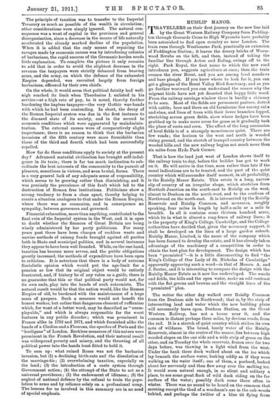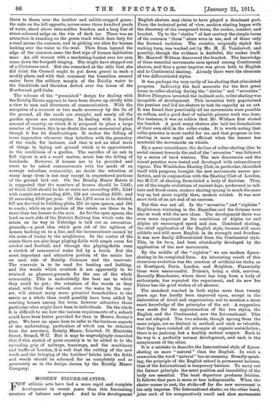RUISLIP MANOR.
TRAVELLERS on their first journey on the new line laid by the Great Western Railway Company from Padding.. ton through Gerrards Cross to High Wycombe have probably been astonished to find open country so near London. The train runs through Westhourne Park, practically an extension of Paddington Station ; it leaves the dreary bricks of Worm- wood Scrubs on the left, and then, instead of taking the familiar line through Acton and Ealing, swings off to the right. Park Royal, the first name to which the new road introduces you, suggests agriculture at once; then the train crosses the river Brent, and you are among level meado ;vs and bare plough. If you know where to look for it, you can get a glimpse of the Brent Valley Bird Sanctuary, and as you go further westward you can understand the reason why the migrant birds have not yet deserted that happy little wood. From the railway carriage window there is hardly a chimney to he seen. Most of the fields are permanent pasture, dotted with cattle; here and there an old farmhouse lies among oats and elms, and lines of trees with their lower branches lopped, stretching across green fields, show where hedges have been grubbed up to make more room for grass as it gradually took the place of roots and corn. The effect of the long succession of level fields is of a strangely monotonous quiet. There are few roads ; the horizon to the west and north is wooded rising ground, and the stretch of tranquil country between the wooded hills and the new railway begins not much more than six miles from Hyde Park Corner.
That is how the land just west of London shows itself to the railway train to-day, before the builder has got to work on it. He will arrive in due time, soon rather than late if the usual indications are to be trusted, and the part of the quiet country which will surrender itself soonest, in all probability, is the Ruislip Manor Estate. This estate is a long, narrow slip of country of an irregular shape, which stretches from Northolt Junction on the south-east to Ruislip on the west, almost to Denham on the north-west, and to the confines of Northwood on the north-east. It is intersected by the Ruislip Reservoir and Ruislip Common, and measures, roughly speaking, four miles in length by half-a.-mile or a mile in breadth. In all it contains some thirteen hundred acres, which lie in what is almost a ring-fence of railway lines ; it is the property of King's College. Cambridge, and the College authorities have decided that, given the necessary support, it shall be developed on the lines of a large garden suburb. Ruislip Manor, Limited, is the name of the company which has been formed to develop the estate, and it has already taken advantage of the machinery of a competition in order to obtain the best plan for development. The design which has been " premiated "—it is a little disconcerting to find "the King's College of Our Lady of St. Nicholas of Cambridge" apparently approving such a word—is that of Messrs. A. and J. Soutar, and it is interesting to compare the design with the Ruislip Manor Estate as it now lies undeveloped. The woods and fields, the hills and the open water, make an odd contrast with the flat greens and browns and the straight lines of the "premiated" plan.
The writer the other day walked over Ruislip Common from the Denham side to Northwood; that is, by the strip of intersecting land and water which the new building plans will necessarily leave open. Denham Station, on the Great Western Railway, has not a house near it, and the common is distant perhaps three miles, by devious roads, from the rail. It is a stretch of quiet country which strikes its own note of wildness. The broad, lonely water of the Ruislip Reservoir, almost in the centre of the manor, lies between high wooded slopes on the one side and a wide strip of grass on the other, and on Tuesday the whole reservoir, frozen over for two days before, was thawing in a light wind from the west. Under the bank three duck walked about on the ice which lay beneath the surface water, looking oddly as if they were walking on the water itself ; one of them, a pochard, looked about her nervously and then flew away over the melting ice. It would seem natural enough, in so silent and solitary a place, to see some great flock of wild duck riding on the far surface of the water; possibly duck come there often in winter. There was no sound to be heard on the common that morning except the thud of a woodman's axe in the oak-woods behind, and perhaps the twitter of a blue tit flying f • om thorn to thorn over the heather and rabbit-cropped grass ; the oaks on the hill opposite, across some three hundred yards of water, stood above rain-sodden bracken and a long line of Straw-coloured sedge on the rim of dark ice. There was an attraction in standing on the green track which does duty for a road across the common, and in picking out sites for houses looking over the water to the west. Then from beyond the edge of the common came the first sign of human habitation near. An old woman with a marketing-basket over her arm came down the footpath singing. She might have stepped out of a Christmas-card. But she remarked at the stile that she did think the Council ought to put down gravel in such a muddy place, and with that comment the transition seemed easier from the solitary margin of the Ruislip water to the blackbirds and thrashes dotted over the lawns of the Northwood golf-links.
The scheme of the " premiated " design for dealing with the Ruislip Estate appears to have been drawn up chiefly with a view to ease and directness of communication. With the exception of a crescent or two made necessary by the lie of the ground, all the roads are straight, and nearly all the garden spaces are rectangular. In dealing with a limited amount of country, on which it is proposed to place a large number of houses, this is no doubt the most economical plan, though it has its disadvantages. It makes the felling of trees imperative whenever they interfere with the geometry of the roads, for instance, and that is not an ideal state of things in laying out ground which is to approximate to the conditions of a garden. The sacrifice of an oak in full vigour is not a small matter, much less the felling of hundreds. However, if houses are to be provided and rents to be asked commensurate with the needs of an average suburban community, no doubt the retention of many large trees is not easy except in sequestered portions of the ground laid. oat. On the Ruislip Manor Estate it is suggested that the numbers of houses should be 7,642; of which 3,556 should be let at rents not exceeding £30; 3,541 with rentals not exceeding £60; 524 not exceeding £100; and 21 exceeding £100 per year. Of the 1,276 acres to be divided, 837 are devoted to building-plots, 255 to open spaces, and 184 to roads ; while on no portion of the estate are there to be more than ten houses to the acre. As for the open spaces, the land on each side of the District Railway line which cuts the estate on its • way to Uxbridge is laid out as recreation- grounds,—a good idea which gets rid of the ugliness of houses backing on to a line, and the inconvenience caused by the noise of trains to the neighbours. In the centre of the estate there are also large playing-fields with ample room for cricket and football, and through the playing-fields runs a stretch of ornamental water fed by a brook. But the most important and attractive portion of the estate lies on each side of Ruislip Common and the reservoir. The reservoir is to be used for boating and bathing, and the woods which overlook it are apparently to be retained as pleasure-grounds for the use of the whole community. This is undoubtedly the best use to which they could be put ; the retention of the woods as they stand, with their fine outlook over the water to the sun- set, will attract many more potential householders to the estate as a whole than could possibly have been added by erecting houses among the trees, however attractive those particular sites might have been to individuals. On the whole it is difficult to see how the various requirements of a suburb could have been better provided for than in Messrs. Soutar's plan. We have no space here to refer to the business aspects of the undertaking, particulars of which can be obtained from the secretary, Ruislip Manor, Limited, 33 Henrietta Street, Strand, W.C. But it may be ungrudgingly conceded that if this stretch of quiet country is to be added in to the spreading grip of railways, tramways, and the machinery and traffic of London, it is well that the cutting of the new roads and the bringing of the builders' bricks into the fields and woods should be schemed for as completely and as generously as in the design chosen by the Ruislip Manor Company.











































 Previous page
Previous page